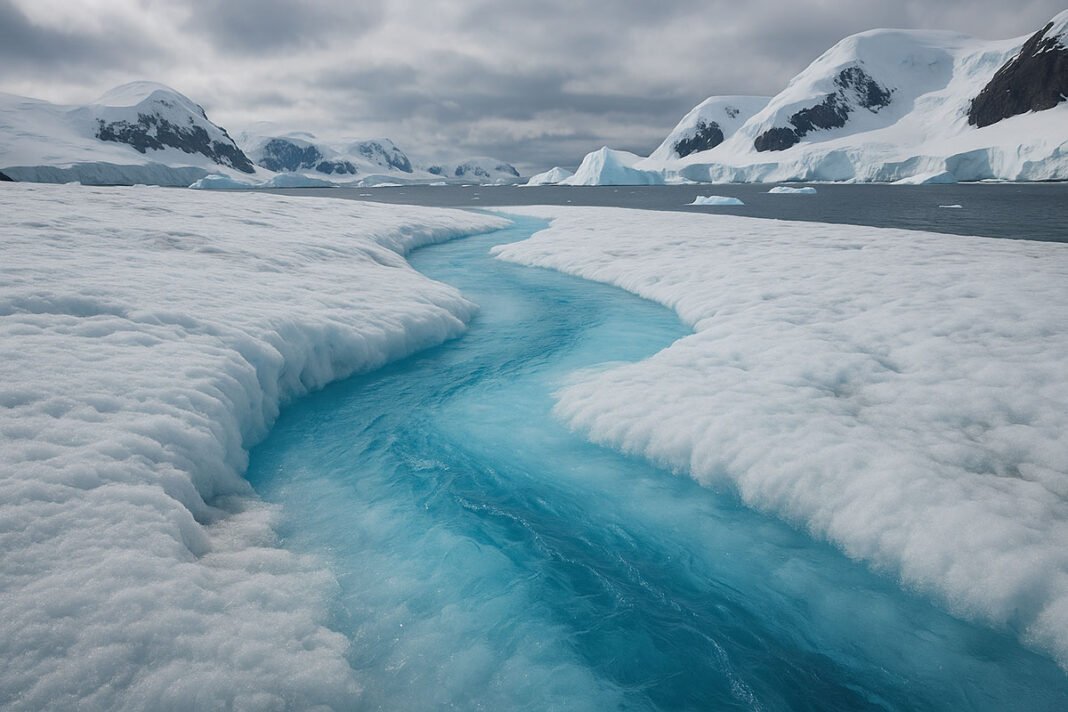Recent Antarctic research reveals accelerating ice loss patterns from sub-Antarctic islands to the continental ice sheets, with Heard Island’s 22% glacier decline over 72 years exemplifying broader regional trends. Antarctica currently loses approximately 150 gigatons of ice annually¹, contributing 0.4 millimeters per year to global sea level rise, while unprecedented “five-sigma” sea ice events in 2023 signal fundamental changes in the Southern Ocean system that could accelerate future ice sheet losses².
The convergence of satellite observations, field studies, and climate modeling now provides an increasingly coherent picture of Antarctic ice dynamics. Monash University’s groundbreaking research on Heard Island, published in The Cryosphere in 2025, demonstrates how sub-Antarctic glaciers serve as sentinels for broader Antarctic changes. The study’s finding of accelerated retreat after 1988—from 0.25% to 0.43% annual loss—parallels acceleration patterns observed across the Antarctic continent itself. This research, combined with evidence of Southern Ocean warming reaching 0.8-2.0°C in critical regions³, reveals interconnected mechanisms driving ice loss from the sub-Antarctic islands to the heart of Antarctica.
Heard Island findings reveal broader sub-Antarctic patterns
The Monash University Securing Antarctica’s Environmental Future (SAEF) research documented Heard Island’s glacier area reduction from 289.4 km² in 1947 to 225.7 km² in 2019, with eastern-facing glaciers experiencing the most severe losses at 30% during 1988-2019⁴. Individual glaciers like Stephenson showed maximum retreat of 5.8 kilometers, with annual retreat rates accelerating from 80.7 to 178.7 meters per year after 1988.
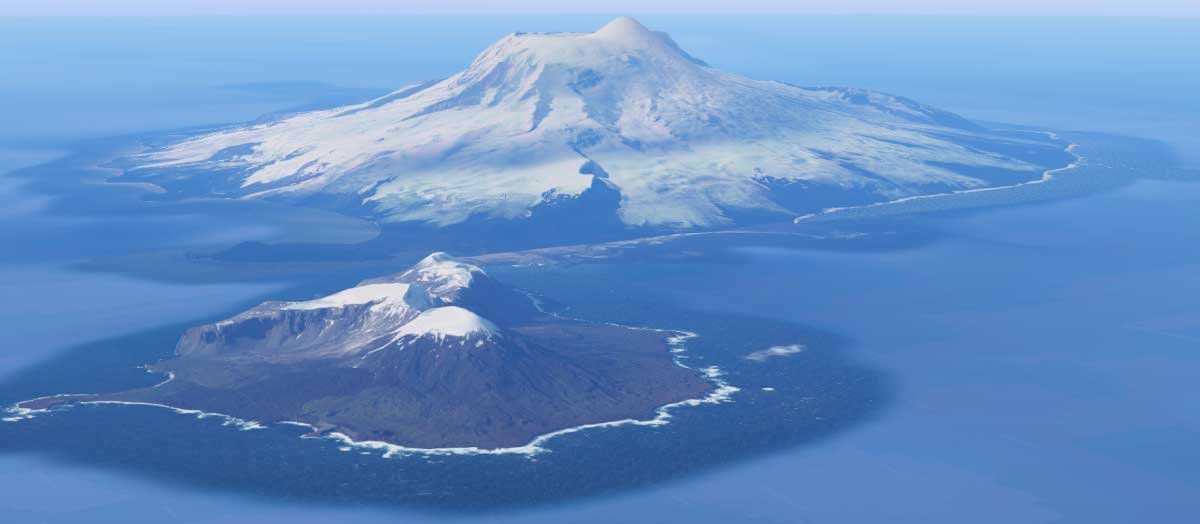
This pattern extends across the sub-Antarctic region. Kerguelen Islands’ Cook Ice Cap demonstrates among the world’s highest glacier retreat rates during the 2000s, with 77% of negative mass balance attributed to atmospheric drying⁵ linked to poleward-shifting westerly winds. Marion Island has experienced complete loss of its permanent ice features since the 1960s, while South Georgia shows continuous glacier retreat since the Antarctic Cold Reversal ended 12,800 years ago. The consistent orographic effect—where eastern-facing glaciers retreat faster due to warmer, drier conditions on the leeward side of prevailing westerlies—appears across all sub-Antarctic territories, driven by a 0.7°C temperature increase over the past seven decades.
Surface debris cover on Heard Island glaciers increased from 7.0% to 12.8% between 1988 and 2019, with the maximum elevation of debris shifting upward by 320 meters. This upward migration of the ablation zone reflects warming temperatures penetrating to higher elevations, a pattern observed across multiple sub-Antarctic locations and indicative of accelerating climate impacts on these sensitive polar environments.
Antarctic ice sheets show unprecedented dynamics across all regions
West Antarctica dominates continental ice loss, contributing approximately 150 gigatons annually⁶ according to NASA GRACE data from 2002-2023. The Amundsen Sea Embayment alone loses 447.9 ± 14.7 gigatons per year (2018-2022), accounting for 8% of the current global sea level rise rate of 4.6 millimeters annually⁷. Recent research published in The Cryosphere (2025) suggests that current mass loss rates may already constitute sufficient precursors for irreversible West Antarctic Ice Sheet collapse, even without additional climate forcing.
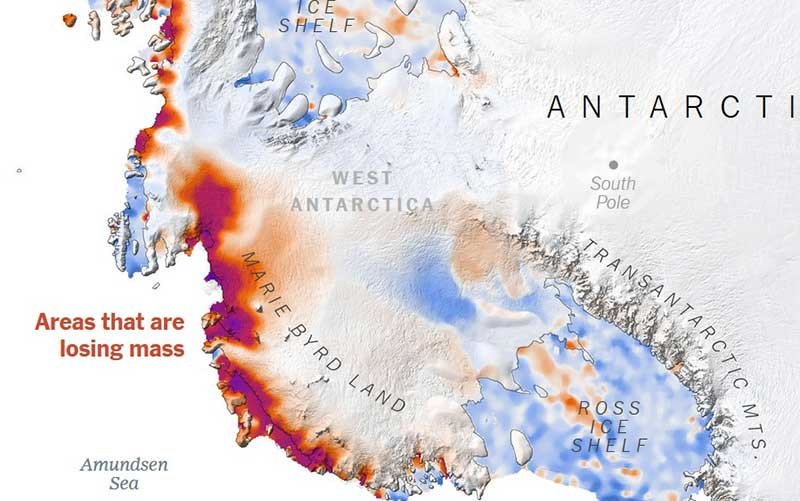
Thwaites Glacier, often called the “Doomsday Glacier,” shows retreat rates up to 1.2 kilometers per year on its eastern shelf⁸, with potential to contribute 65 centimeters to sea level if completely lost. Pine Island Glacier’s losses increased from 80 gigatons annually (1979-1989) to 133 gigatons (2009-2017), experiencing a 77% velocity increase from 1974 to 2013⁹. The Pope, Smith, and Kohler glacier system demonstrates extreme retreat rates, with Pope Glacier retreating 3.5 kilometers in just 3.6 months during 2017—a rate of 11.7 kilometers per year, twelve times faster than typical Alpine glacier retreat¹⁰.
East Antarctica, traditionally viewed as stable, shows emerging vulnerability. While a temporary mass gain of 107.79 gigatons per year occurred during 2021-2023 due to anomalous precipitation¹¹, this masks underlying instability. Prior losses accelerated from 73.79 gigatons annually (2002-2010) to 142.06 gigatons (2011-2020). The Wilkes Land region, particularly Totten Glacier, shows significant thinning driven by enhanced basal melting, while Denman Glacier sits atop the world’s deepest continental canyon at 3.5 kilometers depth, making it vulnerable to warm ocean intrusion.
The Antarctic Peninsula reveals that 87% of glaciers along its western coastline are retreating¹², with average retreat rates of 50 meters per year over the past five years—the fastest in the 50-year observational record. Ocean-induced melting drives this retreat, with strong correlation between mid-depth ocean temperatures and glacier-front changes. The 2024-2025 melt season showed record extent in December and January, though an abrupt February cooling ended the season early¹³.
Advanced satellite monitoring captures accelerating changes
ICESat-2’s Advanced Topographic Laser Altimeter System, operational since 2018, delivers unprecedented precision with 10,000 laser pulses per second compared to its predecessor’s 40. This system measures annual height changes accurate to within 4 millimeters¹⁴, providing the first high-resolution Antarctic grounding zone product with 21,346 identified locations. The satellite’s 17-meter diameter footprints with 0.7-meter along-track sampling enable detection of subtle elevation changes critical for understanding ice sheet dynamics.
GRACE and GRACE-FO gravity measurements from 2002-2023 confirm Antarctica’s average loss of 150 gigatons annually, though with significant temporal variability¹⁵. The 2021-2023 period showed a temporary mass gain of 119 billion tons per year due to exceptional East Antarctic snowfall—a finding that demonstrates the ice sheet’s sensitivity to atmospheric circulation changes while not offsetting long-term accelerated losses¹⁶. CryoSat-2’s synthetic aperture radar interferometry provides 96% Antarctic coverage with five times better coastal sampling than previous missions¹⁷, revealing elevation losses up to 6 meters per year in critical areas like Pine Island and Thwaites glaciers.
New remote sensing techniques include multi-mission data fusion combining GRACE-FO, ICESat-2, and CryoSat-2 with climate models at 50-kilometer resolution. The ITS_LIVE project delivers global ice velocity maps at 100-meter resolution using 10,690 Landsat scenes, enabling real-time monitoring through cloud-based processing. Chinese satellites like Fengyun-3E now distinguish first-year from multi-year ice, adding new capabilities to the global monitoring constellation¹⁸.
Sea ice monitoring revealed 2024’s minimum extent of 768,000 square miles on February 20—the second-lowest on record¹⁹—followed by a September maximum of 17.16 million square kilometers, also the second-lowest²⁰. The dramatic shift from a pre-2014 growth trend of 1% per decade to post-2014 decline represents a fundamental change in Antarctic sea ice behavior²¹, with the 2025 summer minimum of 1.98 million square kilometers falling 30% below the 1981-2010 average²².
Southern Ocean warming drives interconnected ice loss
Mid-depth Circumpolar Deep Water off East Antarctica warmed by 0.8-2.0°C between the 1930-1990 and 2010-2018 periods²³, while sub-Antarctic islands show warming trends of 2.3-2.9°C per century since 2000. Under extreme warming scenarios, Antarctic ice shelf basal melt rates could increase from current levels of 1,180 to 15,700 gigatons per year, with average melt rates rising from 0.8 to 10.6 meters annually.
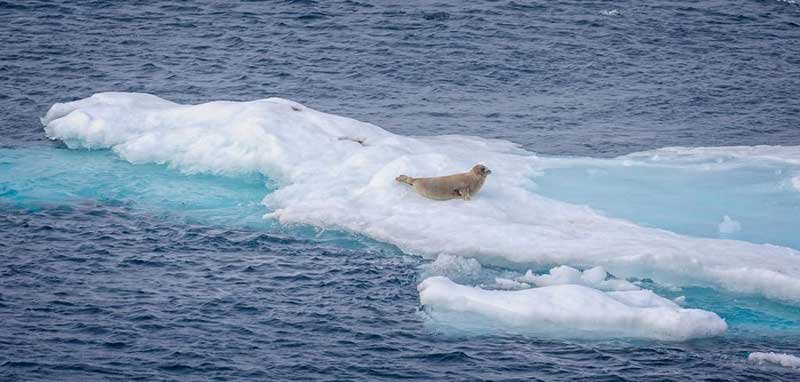
The Southern Ocean absorbs 40% of global oceanic carbon uptake and 67-98% of global ocean heat uptake, making it Earth’s primary heat sink. The Antarctic Circumpolar Current shows a projected 20% slowdown by 2050²⁴ due to increased meltwater input, fundamentally altering regional oceanography. Four distinct seasonal regimes control warm water intrusion onto continental shelves: East Antarctica’s wind-driven dynamics, West Antarctica’s undercurrent strength variations, the Adélie Coast’s interplay with dense shelf water production, and canyon-edge inflow patterns in the Ross and Weddell seas.
Positive feedback loops amplify these processes. Ice shelf melting introduces freshwater that enhances undercurrents, increasing warm water transport and driving further melting. Reduced sea ice formation decreases dense shelf water production, weakening natural barriers to warm water intrusion. Meltwater stratification reduces vertical heat transport, causing subsurface warming that further threatens ice shelf stability. These mechanisms create an accelerating cycle where initial perturbations trigger progressively larger responses across the coupled ice-ocean-atmosphere system.
Five-sigma events signal Antarctic system transformation
Antarctic sea ice experienced unprecedented “five-sigma” events in 2023, with ice extent falling five to six standard deviations below the mean—statistically expected only once every 7.5 million years under stable climate conditions²⁵. The 2023 winter maximum was 398,000 square miles below the previous record low from 1986, while some analyses detected deviations reaching 6.4 standard deviations, representing a theoretical 13-billion-year event²⁶.
These extreme anomalies indicate fundamental system behavior changes far outside natural variability. Antarctic sea ice showed a slight increasing trend from 1979-2014 before dramatically shifting post-2016 to persistent below-average extents²⁷. Change point analysis identifies three distinct periods: gradual increase (1978-2007), high variability (2007-2016), and consistently low state (2016-2023). The physical mechanisms include subsurface Southern Ocean warming that began before 2016, increased ocean heat content reaching ice shelf bases, altered atmospheric circulation patterns including El Niño and Southern Annular Mode variations, and self-reinforcing feedback loops where less ice leads to more heat absorption.
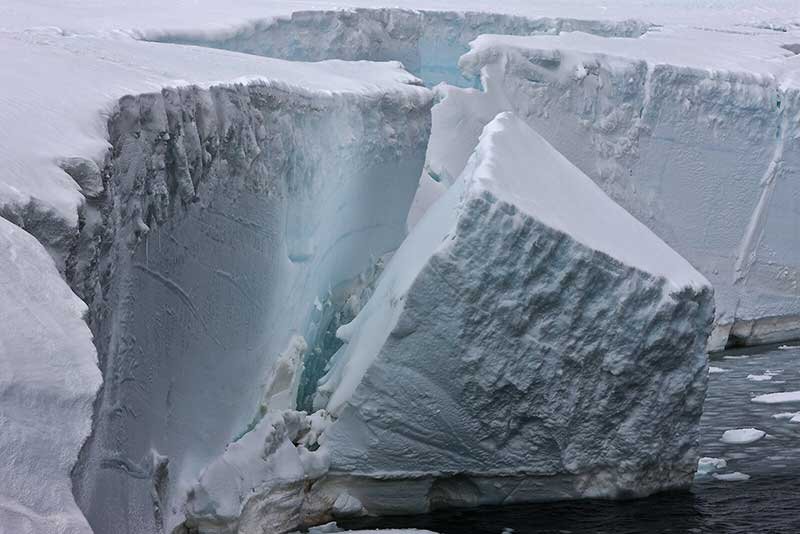
While sea ice doesn’t directly contribute to sea level rise, these extremes indicate unprecedented Southern Ocean changes that could accelerate ice sheet losses. The 2023 events doubled winter ocean heat loss, potentially affecting global circulation patterns. Extreme sea ice loss exposes ice shelves to increased wave action and warmer waters, while critical habitat loss threatens Antarctic ecosystems, particularly Emperor penguins. These changes may activate marine ice sheet instability mechanisms, accelerating continental ice loss beyond current projections.
Future projections reveal delayed but dramatic scenario divergence
Climate models show surprisingly limited differentiation between emission scenarios through 2100, with Antarctic contributions ranging from -5 to +16 centimeters regardless of pathway²⁸. However, dramatic divergence emerges after 2150, with low emissions (SSP1-2.6) producing 0.45-1.57 meters by 2300, while high emissions (SSP5-8.5) yield 1.96-3.79 meters of sea level rise from Antarctica alone²⁹.
Coupled climate-ice sheet models reveal important feedback effects, with Antarctic meltwater reducing regional surface temperatures by approximately 1.4°C³⁰. This freshwater-induced cooling reduces surface melting while enhanced subsurface warming increases basal melting, resulting in net lower sea level contributions than uncoupled models predict. The time lag between peak warming and maximum ice sheet response extends beyond 100 years, meaning ice sheets continue accelerating long after emissions cease.
Regional projections show West Antarctica contributing the majority of near-term losses, with the Amundsen Sea Embayment displaying highest sensitivity to ocean warming. Marine ice sheet instability may already be underway, with grounding line retreat accelerating regardless of emission scenario through 2050³¹. East Antarctica’s Wilkes Basin, containing 3-4 meters of sea level equivalent, shows vulnerability to tipping at lower warming levels than previously thought. Temperature thresholds indicate the Ross Ice Shelf could collapse around 3.5-4°C warming, always tipping above 4°C but never below 3°C³². The West Antarctic Ice Sheet appears likely committed to collapse even if warming remains at 2020 levels, while East Antarctic subglacial basins show tipping points possible at 1.75-3°C warming³³.
The policy implications are profound: while emission pathways show similar impacts through 2100, current century emissions determine irreversible multi-century commitments. Some Antarctic changes are already locked in, with response times extending centuries beyond initial forcing. Regional monitoring must focus on West Antarctic instability indicators and major ice shelf stability assessments. Adaptation planning must account for potential multi-meter sea level rise by 2300 under current emission trajectories, recognizing that decisions made in the coming decades will determine coastal configurations for millennia.
Bibliography
- NASA Scientific Visualization Studio. “Antarctic Ice Mass Loss 2002-2023.” https://svs.gsfc.nasa.gov/31158/
- Science Alert. “6.4-Sigma Event: Antarctic Sea Ice Hits Lowest Point Since Official Records Began.” https://www.sciencealert.com/6-4-sigma-event-antarctic-sea-ice-hits-lowest-point-since-official-records-began
- NOAA Climate.gov. “Antarctica is colder than the Arctic, but it’s still losing ice.” https://www.climate.gov/news-features/features/antarctica-colder-arctic-it%E2%80%99s-still-losing-ice
- Original ABC News article on Heard Island glacier research by Jano Gibson, citing Monash University SAEF research center findings
- MDPI. “Ice Sheet Mass Changes over Antarctica Based on GRACE Data.” https://www.mdpi.com/2072-4292/16/20/3776
- GRACE Tellus. “GRACE and GRACE-FO polar ice mass loss.” https://grace.jpl.nasa.gov/resources/41/grace-and-grace-fo-polar-ice-mass-loss/
- GRACE Tellus. “Antarctic Ice Loss 2002-2020.” https://grace.jpl.nasa.gov/resources/31/antarctic-ice-loss-2002-2020/
- Wikipedia. “Thwaites Glacier.” https://en.wikipedia.org/wiki/Thwaites_Glacier
- PNAS. “Four decades of Antarctic Ice Sheet mass balance from 1979–2017.” https://www.pnas.org/doi/10.1073/pnas.1812883116
- NASA Scientific Visualization Studio. “West Antarctic Glacier Ice Flows and Elevation Change.” https://svs.gsfc.nasa.gov/3875
- SciTechDaily. “Antarctica’s Astonishing Rebound: Ice Sheet Grows for the First Time in Decades.” https://scitechdaily.com/antarcticas-astonishing-rebound-ice-sheet-grows-for-the-first-time-in-decades/
- Copernicus. “The Antarctic contribution to 21st-century sea-level rise predicted by the UK Earth System Model with an interactive ice sheet.” https://tc.copernicus.org/articles/16/4053/2022/
- National Snow and Ice Data Center. “Antarctic Ice Sheet 2024 to 2025 melt season: Fast start, early end.” https://nsidc.org/ice-sheets-today/analyses/antarctic-ice-sheet-2024-2025-melt-season-fast-start-early-end
- IEEE Spectrum. “Satellite Tech Opens New Window on Antarctic.” https://spectrum.ieee.org/antarctic-sea-ice-monitoring-satellite
- Earth.gov. “GRACE and GRACE-FO Observations of Polar Ice Mass Loss.” https://earth.gov/sealevel/resources/339/grace-and-grace-fo-observations-of-polar-ice-mass-loss/
- Live Science. “NASA satellites show Antarctica has gained ice despite rising global temperatures. How is that possible?” https://www.livescience.com/planet-earth/antarctica/nasa-satellites-show-antarctica-has-gained-ice-despite-rising-global-temperatures-how-is-that-possible
- Wiley Online Library. “Increased ice losses from Antarctica detected by CryoSat‐2.” https://agupubs.onlinelibrary.wiley.com/doi/abs/10.1002/2014GL060111
- Space.com. “NASA satellites show Antarctica has gained ice despite rising global temperatures. How is that possible?” https://www.space.com/astronomy/earth/nasa-satellites-show-antarctica-has-gained-ice-despite-rising-global-temperatures-how-is-that-possible
- National Snow and Ice Data Center. “Antarctic sea ice minimum hits a near-record low, again.” https://nsidc.org/sea-ice-today/analyses/antarctic-sea-ice-minimum-hits-near-record-low-again
- NOAA Climate.gov. “2024 Antarctic sea ice winter maximum second lowest on record.” https://www.climate.gov/news-features/event-tracker/2024-antarctic-sea-ice-winter-maximum-second-lowest-record
- NOAA Climate.gov. “Understanding climate: Antarctic sea ice extent.” https://www.climate.gov/news-features/understanding-climate/understanding-climate-antarctic-sea-ice-extent
- NOAA Climate.gov. “2025 summer minimum sea ice extent in Antarctic tied for second-lowest on record.” https://www.climate.gov/news-features/event-tracker/2025-summer-minimum-sea-ice-extent-antarctic-tied-second-lowest-record
- Australian Antarctic Program. “Understanding Antarctica’s contribution to sea level rise.” https://www.antarctica.gov.au/news/2024/improving-global-sea-level-rise-projections-and-community-response/
- Carbon Brief. “Guest post: How close is the West Antarctic ice sheet to a ‘tipping point’?” https://www.carbonbrief.org/guest-post-how-close-is-the-west-antarctic-ice-sheet-to-a-tipping-point/
- Ground Report. “Know about five sigma event happening in Antarctica due to climate change.” https://groundreport.in/know-about-five-sigma-event-happening-in-antarctica-due-to-climate-change/
- Science Alert. “6.4-Sigma Event: Antarctic Sea Ice Hits Lowest Point Since Official Records Began.” https://www.sciencealert.com/6-4-sigma-event-antarctic-sea-ice-hits-lowest-point-since-official-records-began
- Nature Communications Earth & Environment. “Record low Antarctic sea ice coverage indicates a new sea ice state.” https://www.nature.com/articles/s43247-023-00961-9
- Nature Communications Earth & Environment. “The influence of emissions scenarios on future Antarctic ice loss is unlikely to emerge this century.” https://www.nature.com/articles/s43247-021-00289-2
- Dartmouth. “West Antarctic Ice Sheet May Disappear by 2300.” https://home.dartmouth.edu/news/2024/09/antarctic-ice-sheet-may-disappear-2300
- Nature Communications. “Future sea-level projections with a coupled atmosphere-ocean-ice-sheet model.” https://www.nature.com/articles/s41467-023-36051-9
- Carbon Brief. “Tipping points: Window to avoid irreversible climate impacts is ‘rapidly closing’.” https://www.carbonbrief.org/tipping-points-window-to-avoid-irreversible-climate-impacts-is-rapidly-closing/
- Nature. “Contribution of Antarctica to past and future sea-level rise.” https://www.nature.com/articles/nature17145
- Carbon Brief. “Guest post: How close is the West Antarctic ice sheet to a ‘tipping point’?” https://www.carbonbrief.org/guest-post-how-close-is-the-west-antarctic-ice-sheet-to-a-tipping-point/
